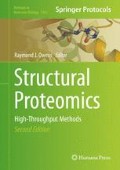Abstract
We present a technology for the production of target proteins using novel cell-free systems derived from cultured human K562 cells and Chinese hamster ovary (CHO) cells. The protocol includes the cultivation of cells, the preparation of translationally active lysates, and the cell-free synthesis of desired proteins. An efficient expression vector based on the internal ribosome entry site (IRES) from the intergenic region (IGR) of the cricket paralysis virus (CrPV) was constructed for both systems. The coupled batch-based platforms enable the synthesis of a broad range of target proteins such as cytosolic proteins, secreted proteins, membrane proteins embedded into endogenous microsomes, and glycoproteins. The glycosylation of erythropoietin demonstrates the successful performance of posttranslational modifications in the novel cell-free systems. Protein yields of approximately 20 μg/ml (K562-based cell-free system) and 50 μg/ml (CHO-based cell-free system) of active firefly luciferase are obtained in the coupled transcription-translation systems within 3 h. As a result, both cell-free protein synthesis systems serve as powerful tools for high-throughput proteomics.
Access this chapter
Tax calculation will be finalised at checkout
Purchases are for personal use only
References
Madin K, Sawasaki T, Ogasawara T et al (2000) A highly efficient and robust cell-free protein synthesis system prepared from wheat embryos: plants apparently contain a suicide system directed at ribosomes. Proc Natl Acad Sci U S A 97:559–564
Hodgman CE, Jewett MC (2013) Optimized extract preparation methods and reaction conditions for improved yeast cell-free protein synthesis. Biotechnol Bioeng 110:2643–2654
Martoglio B, Dobberstein B (2006) Cotranslational translocation of proteins into microsomes derived from the rough endoplasmic reticulum of mammalian cells. In: Celis JE (ed) Cell biology: a laboratory handbook. Academic, New York, pp 215–221
Kubick S, Schacherl J, Fleischer-Notter H et al (2003) In vitro translation in an insect-based cell-free system. In: Swartz J (ed) Cell-free protein expression. Springer, Berlin, pp 209–217
Kubick S, Gerrits M, Merk H et al (2009) In vitro synthesis of posttranslationally modified membrane proteins. In: Larry D (ed) Current topics in membranes, vol 63(2). Academic, New York, pp 25–49
Sachse R, Wüstenhagen D, Šamalíková M et al (2012) Synthesis of membrane proteins in eukaryotic cell-free systems. Eng Life Sci 13:39–48
Royall E, Woolaway KE, Schacherl J et al (2004) The Rhopalosiphum padi virus 59 internal ribosome entry site is functional in Spodoptera frugiperda 21 cells and in their cell-free lysates: Implications for the baculovirus expression system. J Gen Virol 85:1565–1569
Mikami S, Kobayashi T, Imataka H (2010) Cell-free protein synthesis systems with extracts from cultured human cells. Methods Mol Biol 607:43–52
Mikami S, Masutani M, Sonenberg N et al (2006) An efficient mammalian cell-free translation system supplemented with translation factors. Protein Expr Purif 46:348–357
Zeenko VV, Wang C, Majumder M et al (2008) An efficient in vitro translation system from mammalian cells lacking the translational inhibition caused by eIF2 phosphorylation. RNA 14:593–602
Nozawa A, Ogasawara T, Matsunaga S et al (2011) Production and partial purification of membrane proteins using a liposome-supplemented wheat cell-free translation system. BMC Biotechnol 11:35
Orth JHC, Br S, Boundy S et al (2010) Cell-free synthesis and characterization of a novel cytotoxic pierisin-like protein from the cabbage butterfly Pieris rapae. Toxicon 57:199–207
Bechlars S, Wüstenhagen DA, Drägert K et al (2013) Cell-free synthesis of functional thermostable direct hemolysins of Vibrio parahaemolyticus. Toxicon 76:132–142
Stech M, Merk H, Schenk JA et al (2012) Production of functional antibody fragments in a vesicle-based eukaryotic cell-free translation system. J Biotechnol 164:220–231
Merk H, Gless C, Maertens B et al (2012) Cell-free synthesis of functional and endotoxin-free antibody Fab fragments by translocation into microsomes. Biotechniques 53:153–160
Brödel AK, Raymond JA, Duman JG et al (2013) Functional evaluation of candidate ice structuring proteins using cell-free expression systems. J Biotechnol 163:301–310
Braun P, LaBaer J (2003) High-throughput protein production for functional proteomics. Trends Biotechnol 21:383–388
Jayapal K, Wlaschin K, Hu W et al (2007) Recombinant protein therapeutics from CHO cells - 20 years and counting. Chem Eng Prog 103:40–47
Endo Y, Sawasaki T (2006) Cell-free expression systems for eukaryotic protein production. Curr Opin Biotechnol 17:373–380
Ezure T, Suzuki T, Higashide S et al (2006) Cell-free protein synthesis system prepared from insect cells by freeze-thawing. Biotechnol Prog 22:1570–1577
Brödel AK, Sonnabend A, Kubick S (2014) Cell-free protein expression based on extracts from CHO cells. Biotechnol Bioeng 111:25–36
Stech M, Brödel AK, Sachse R et al (2013) Cell-free systems: functional modules for synthetic and chemical biology. In: Scheper T, Belkin S, Doran PM et al (eds) Advances in biochemical engineering biotechnology, vol 137. Springer, Berlin, pp 67–102
Brödel AK, Sonnabend A, Roberts LO et al (2013) IRES-mediated translation of glycoproteins and membrane proteins in eukaryotic cell-free systems. PLoS One 8:e82234
Angenendt P, Nyarsik L, Szaflarski W et al (2004) Cell-free protein expression and functional assay in nanowell chip format. Anal Chem 76:1844–1849
Voloshin AM, Swartz JR (2008) Large-scale batch reactions for cell-free protein synthesis. In: Spirin AS, Swartz JR (eds) Cell-free protein synthesis. Wiley, Weinheim, pp 207–235
Swartz J (2006) Developing cell-free biology for industrial applications. J Ind Microbiol Biotechnol 33:476–485
Stoevesandt O, Taussig MJ, He M (2009) Protein microarrays: high-throughput tools for proteomics. Expert Rev Proteomics 6:145–157
Spirin AS, Swartz JR (2008) Cell-free protein synthesis systems: historical landmarks, classification, and general methods. In: Spirin AS, Swartz JR (eds) Cell-free protein synthesis. Wiley, Weinheim, pp 1–34
Acknowledgment
This research is supported by the German Ministry of Education and Research (BMBF Nos. 0312039 and 0315942).
Author information
Authors and Affiliations
Corresponding author
Editor information
Editors and Affiliations
Rights and permissions
Copyright information
© 2015 Springer Science+Business Media New York
About this protocol
Cite this protocol
Brödel, A.K., Wüstenhagen, D.A., Kubick, S. (2015). Cell-Free Protein Synthesis Systems Derived from Cultured Mammalian Cells. In: Owens, R. (eds) Structural Proteomics. Methods in Molecular Biology, vol 1261. Humana Press, New York, NY. https://doi.org/10.1007/978-1-4939-2230-7_7
Download citation
DOI: https://doi.org/10.1007/978-1-4939-2230-7_7
Published:
Publisher Name: Humana Press, New York, NY
Print ISBN: 978-1-4939-2229-1
Online ISBN: 978-1-4939-2230-7
eBook Packages: Springer Protocols

